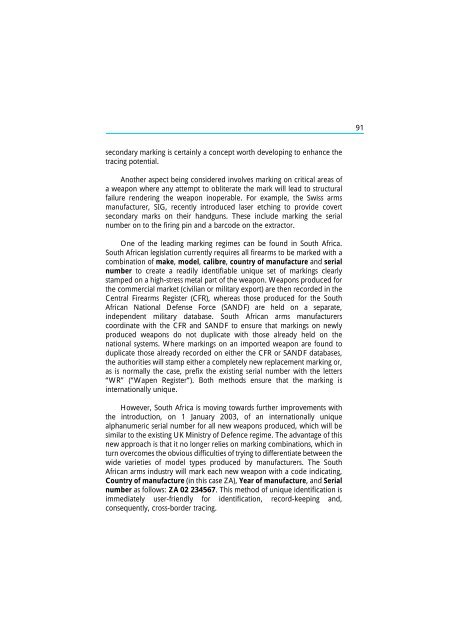The Scope and Implications of a Tracing Mechanism for Small Arms ...
The Scope and Implications of a Tracing Mechanism for Small Arms ...
The Scope and Implications of a Tracing Mechanism for Small Arms ...
Create successful ePaper yourself
Turn your PDF publications into a flip-book with our unique Google optimized e-Paper software.
91<br />
secondary marking is certainly a concept worth developing to enhance the<br />
tracing potential.<br />
Another aspect being considered involves marking on critical areas <strong>of</strong><br />
a weapon where any attempt to obliterate the mark will lead to structural<br />
failure rendering the weapon inoperable. For example, the Swiss arms<br />
manufacturer, SIG, recently introduced laser etching to provide covert<br />
secondary marks on their h<strong>and</strong>guns. <strong>The</strong>se include marking the serial<br />
number on to the firing pin <strong>and</strong> a barcode on the extractor.<br />
One <strong>of</strong> the leading marking regimes can be found in South Africa.<br />
South African legislation currently requires all firearms to be marked with a<br />
combination <strong>of</strong> make, model, calibre, country <strong>of</strong> manufacture <strong>and</strong> serial<br />
number to create a readily identifiable unique set <strong>of</strong> markings clearly<br />
stamped on a high-stress metal part <strong>of</strong> the weapon. Weapons produced <strong>for</strong><br />
the commercial market (civilian or military export) are then recorded in the<br />
Central Firearms Register (CFR), whereas those produced <strong>for</strong> the South<br />
African National Defense Force (SANDF) are held on a separate,<br />
independent military database. South African arms manufacturers<br />
coordinate with the CFR <strong>and</strong> SANDF to ensure that markings on newly<br />
produced weapons do not duplicate with those already held on the<br />
national systems. Where markings on an imported weapon are found to<br />
duplicate those already recorded on either the CFR or SANDF databases,<br />
the authorities will stamp either a completely new replacement marking or,<br />
as is normally the case, prefix the existing serial number with the letters<br />
“WR” (“Wapen Register”). Both methods ensure that the marking is<br />
internationally unique.<br />
However, South Africa is moving towards further improvements with<br />
the introduction, on 1 January 2003, <strong>of</strong> an internationally unique<br />
alphanumeric serial number <strong>for</strong> all new weapons produced, which will be<br />
similar to the existing UK Ministry <strong>of</strong> Defence regime. <strong>The</strong> advantage <strong>of</strong> this<br />
new approach is that it no longer relies on marking combinations, which in<br />
turn overcomes the obvious difficulties <strong>of</strong> trying to differentiate between the<br />
wide varieties <strong>of</strong> model types produced by manufacturers. <strong>The</strong> South<br />
African arms industry will mark each new weapon with a code indicating,<br />
Country <strong>of</strong> manufacture (in this case ZA), Year <strong>of</strong> manufacture, <strong>and</strong> Serial<br />
number as follows: ZA 02 234567. This method <strong>of</strong> unique identification is<br />
immediately user-friendly <strong>for</strong> identification, record-keeping <strong>and</strong>,<br />
consequently, cross-border tracing.
















